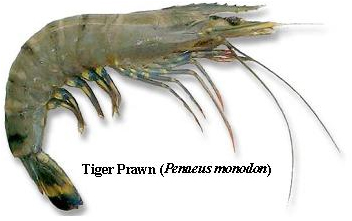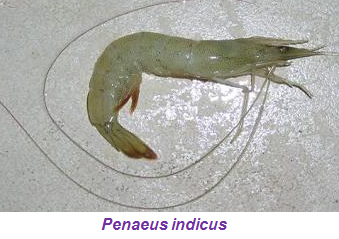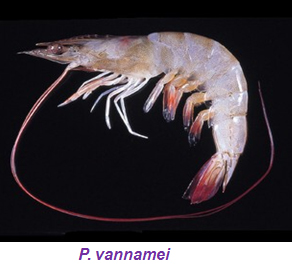Shrimps Culture
1. Area and Production
India is endowed with a long coastline and hence offers scope for large exploitation of marine wealth. Till a few years back, fishermen in India were involving themselves in traditional marine fishing. In the seventies fishermen started concentrating on catching prawns more commonly known as `shrimps' due to high profitable return on the same on account of their export value. Brackish water prawn farming started in a big way during 91-94 especially in the coastal districts of Andhra Pradesh and Tamil Nadu.
The estimated brackish water area suitable for undertaking shrimp cultivation in India is around 11.91 lakhs ha spread over 10 states and union territories viz; West Bengal, Orissa, Andhra Pradesh, Tamil Nadu, Pondicherry, Kerala, Karnataka, Goa, Maharashtra and Gujarat. Of this only around 1.2 lakhs ha are under shrimp farming now and hence lot of scope exists for entrepreneurs to venture into this field of activity. The following table gives the state-wise potential and present level of development.
Statewise shrimp farming area and production in India
| S. No. |
State |
Estimated brackish water area (ha.) |
Area under cultivation (ha.) |
| 1 |
West Bengal |
405,000 |
34,660 |
| 2 |
Orissa |
31,600 |
11,000 |
| 3 |
Andhra Pradesh |
150,000 |
50,000 |
| 4 |
Tamil Nadu |
56,000 |
2,879 |
| 5 |
Pondicherry |
800 |
37 |
| 6 |
Kerala |
65,000 |
14,657 |
| 7 |
Karnataka |
8,000 |
3,500 |
| 8 |
Goa |
18,500 |
650 |
| 9 |
Maharashtra |
80,000 |
716 |
| 10 |
Gujarat |
376,000 |
884 |
| Total |
1,190,000 |
118,983 |
(Source: MPEDA, 2005)
Shrimp species and their suitability
Many factors must be considered when a farmer is deciding which species of shrimp he should culture. Due to its large size and high price, Penaeus monodon and P. indicus are generally considered for farming. It has also been seen that both these species are suitable for farming in Kerala's environment. Apart from these candidate species other commercially important species such as Metapenaeus ensis, M. monoceros, M. brevicornis, Penaeus semisulcatus and P. merguiensis are also potential species that can be grown in India. Another potential candidate species that is flooding international market is the White leg shrimp, Penaeus vannamei. Although the Government of India has not yet given sanctions to culture it in the country, many Asian countries have already started to culture this species.
Advantages of P. monodon
-
It attains a large size. Shrimp with a size of 10 to 12 pieces/kg are common, and sizes of 5 to 7 pieces/kg have been grown in ponds.
-
It is the fastest growing of all shrimp tested for culture. In ponds, juveniles of 3 cm in length have been grown to a size of 75 to 100 g in only five to six months.
-
Due to its large size, it brings a high price to the farmer. At peak seasons it demands over Rs. 450 per kg in India.
-
It can tolerate a wide range of salinity, 0.2 to 70 ppt. Salinity within the range of 10 to 25 ppt has no appreciable effect on growth when food is sufficient. Growth is reported to be slower at very low salinities.
-
It can tolerate temperatures up to at least 37.5°C. Mortalities occur at temperatures below 12°C only.
-
It grows rapidly when fed either with animal or vegetable protein.
-
Food conversion ratios are favourable. Values as low as 1.8:1 have been reported from Taiwan.
-
It is hardy and not greatly disturbed by handling.

Advantages of P. indicus
-
This shrimp grows to a fairly large size and brings a good price.
-
It is fairly fast growing, especially when young. Cultured in tanks at a density of 15/m2, it reached a size of 14 g in 16 weeks. In polyculture with milkfish in earthen ponds, females grew to about 28 g and males to about 12 g in 160 days.
-
Survival is high during the first three months of growth or up to a size of about 10 cm.
-
Wild seeds are usually abundant in estuaries near areas where the adults are present.
-
Gravid females are relatively easy to obtain from the wild in numbers sufficient to operate a hatchery.
-
Females can be matured in captivity with relative ease.
-
This shrimp moves out of a pond with water discharge, making harvesting easy.
-
Good growth has been obtained in intensive culture with a feed having 40 percent protein, which is lower than that required for some other species.
-
The exoskeleton is relatively thin, giving greater portion of edible meat to total weight.

Advantage of P. vannamei
-
Penaeus vannamei has the potential to grow as fast as P. monodon (at up to 3 g/wk) up to 20 g under intensive culture conditions.
-
They are amenable to culture at very high stocking densities of up to 150/m2 in pond culture, and even as high as 400/m2 in controlled recirculated tank culture.
-
Tolerates a wide range of salinities, from 0.5-45 ppt, is comfortable at 7-34 ppt, but grows particularly well at low salinities of around 10-15 ppt.
-
P. vannamei is very tolerant to low temperatures (down to 15°C) enabling them to be cultured in the cold season.
-
P. vannamei require lower protein feed (20-35%) than P. monodon resulting in a reduction in operational costs and amenability for closed, heterotrophic systems and has a better Food Conversion Ratios (FCRs) of 1.2.
-
Specific Pathogen Free (SPF) brood stocks are available for this species to produce disease free larvae.

Top
(Source:Photos courtesy: Shrimp Health Management Extension Manual- MPEDA & NACA
www.fishdb.sinica.edu.tw) |



